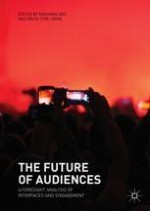2018 | OriginalPaper | Chapter
3. Audiences’ Coping Practices with Intrusive Interfaces: Researching Audiences in Algorithmic, Datafied, Platform Societies
Authors : Anne Mollen, Frederik Dhaenens
Published in: The Future of Audiences
Publisher: Springer International Publishing
Activate our intelligent search to find suitable subject content or patents.
Select sections of text to find matching patents with Artificial Intelligence. powered by
Select sections of text to find additional relevant content using AI-assisted search. powered by
